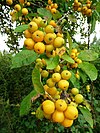Malus
| Malus Temporal range:
| |
|---|---|
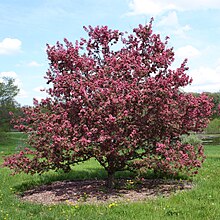
| |
| Malus‘Purple Prince'[1] | |
| Scientific classification | |
| Kingdom: | Plantae |
| Clade: | Tracheophytes |
| Clade: | Angiosperms |
| Clade: | Eudicots |
| Clade: | Rosids |
| Order: | Rosales |
| Family: | Rosaceae |
| Subfamily: | Amygdaloideae |
| Tribe: | Maleae |
| Subtribe: | Malinae |
| Genus: | Malus Mill. |
| Type species | |
| Malus sylvestris Mill.(1768)
| |
| Species | |
|
See text | |
| Synonyms[2] | |
| |
Malus(/ˈmeɪləs/[3]or/ˈmæləs/) is agenusof about 32–57species[4]of smalldeciduoustreesorshrubsin the familyRosaceae,including the domesticated orchardapple,crab apples andwild apples.
The genus isnativeto thetemperatezone of theNorthern Hemisphere.
Description
[edit]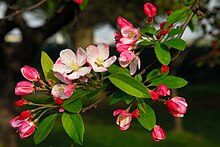
Apple trees are typically 4–12 metres (13–39 feet) talI at maturity, with a dense, twiggy crown. Theleavesare3–10 centimetres (1+1⁄4–4 inches) long, alternate, simple, with a serrated margin. Theflowersare borne incorymbs,and have fivepetals,which may be white, pink, or red, and areperfect,with usually red stamens that produce copiouspollen,and ahalf-inferior ovary;flowering occurs in the spring after 50–80growing degree days(varying greatly according to subspecies andcultivar).[citation needed]
Many apples requirecross-pollinationbetween individuals byinsects(typicallybees,which freely visit the flowers for bothnectarandpollen); these are called self-sterile, so self-pollination is impossible, making pollinating insects essential.[5]
A number of cultivars are self-pollinating, such as 'Granny Smith' and 'Golden Delicious', but are considerably fewer in number compared to their cross-pollination dependent counterparts.[citation needed]
SeveralMalusspecies, including domestic apples,hybridizefreely.[6]
Thefruitis a globosepome,varying in size from1–4 cm (1⁄2–1+1⁄2in) in diameter in most of the wild species, to6 cm (2+1⁄4in) inM. sylvestris sieversii,8 cm (3 in) inM. domestica,and even larger in certain cultivated orchard apples. The centre of the fruit contains fivecarpelsarranged star-like, each containing one or twoseeds.[citation needed]
Subdivisions and species
[edit]36 species and 4 hybrids are accepted.[2]The genusMalusis subdivided into eight sections (six, with two added in 2006 and 2008).[citation needed]The oldest fossils of the genus date to theEocene(Lutetian), which are leaves belonging to the speciesMalus collardiiandMalus kingiensisfrom western North America (Idaho) and theRussian Far East(Kamchatka), respectively.[7]
Species
[edit]36 species and four natural hybrids are accepted:[2]
- Malus angustifolia(Aiton) Michx.– southern crabapple
- Malus asiaticaNakai– Chinese pearleaf crabapple
- Malus baccata(L.) Borkh.– Siberian crabapple
- Malus brevipes– shrub apple
- Malus coronaria(L.) Mill.– sweet crabapple
- Malus crescimannoiRaimondo
- Malus daochengensisC.L.Li
- Malus domestica(Suckow) Borkh.– domestic or orchard apple
- Malus doumeri(Bois) A.Chev.– Taiwan crabapple
- Malus florentina(Zuccagni) C.K.Schneid.– Florentine crabapple, hawthorn-leaf crabapple
- Malus fusca(Raf.) C.K.Schneid.– Oregon or Pacific crabapple
- Malus hallianaKoehne– Hall crabapple
- Malus honanensisRehder
- Malus hupehensis(Pamp.) Rehder– tea crabapple
- Malus ioensis(Alph.Wood) Britton– prairie crabapple
- Malus jinxianensisJ.Q.Deng & J.Y.Hong
- Malus kansuensis(Batalin) C.K.Schneid.– Calva crabapple
- Malus komarovii(Sarg.) Rehder
- Malus leiocalycaS.Z.Huang
- Malus mandshurica(Maxim.) Kom. ex Skvortsov
- Malus muliensisT.C.Ku
- Malus niedzwetzkyana– Niedzwetzky's Apple
- Malus ombrophilaHand.-Mazz.
- Malus orientalisUglitzk.
- Malus prattii(Hemsl.) C.K.Schneid.– Pratt's crabapple
- Malus prunifolia(Willd.) Borkh.– plum-leaf crabapple, Chinese crabapple
- Malus rockiiRehder– native to China and Bhutan
- Malus sikkimensis(Wenz.) Koehne– Sikkim crabapple
- Malus spectabilis(Aiton) Borkh.– Asiatic apple, Chinese crabapple
- Malus spontanea(Makino) Makino
- Malus sylvestris(L.) Mill.– European crabapple
- Malus toringo(Siebold) de Vriese(syns.Malus sargentii,Malus sieboldii) – Sargent crabapple, Toringo crabapple, or Siebold's crabapple
- Malus toringoides(Rehder) Hughes– cut-leaf crabapple
- Malus transitoria(Batalin) C.K.Schneid.– cut-leaf crabapple
- Malus trilobata(Labill. ex Poir.) C.K.Schneid.– Lebanese wild apple, erect crabapple, or three-lobed apple tree
- Malus turkmenorumJuz. & Popov(syn.Malus sieversii) – wild ancestor of cultivated speciesMalus domestica
- Malus yunnanensis(Franch.) C.K.Schneid.– Yunnan crabapple
- Malus zhaojiaoensisN.G.Jiang
- Hybrids
- Malus × floribundaSiebold ex Van Houtte– Japanese flowering crabapple
- Malus × kaido(Wenz.) Pardé(syn.Malus × micromalus) – midget crabapple
- Malus × soulardii(L.H.Bailey) Britton
- Malus × zumi(Matsum.) Rehder
Formerly placed here
[edit]- Macromeles tschonoskii(Maxim.) Koidz.(asMalus tschonoskii(Maxim.) C.K.Schneid.) – Chonosuki crabapple and pillar apple[citation needed]
Selected artificial hybrids
[edit]- Malus × sublobata– yellow autumn crabapple (M. asiatica×M. toringo)
Fossil species
[edit]After[7]
- Malus collardiiAxelrod, North America (Idaho),Eocene
- Malus kingiensisBudants, Kamchatka Peninsula, Russia, Eocene
- Malus florissantensis(Cockerell) MacGinitieGreen River Formation,North America (Colorado) Eocene
- Malus pseudocredneria(Cockerell) MacGinitie Green River Formation, North America (Colorado) Eocene
- Malus idahoensisR.W.Br. North America (Idaho),Miocene
- Malus parahupehensisJ.Hsu and R.W.ChaneyShanwang,Shandong, China, Miocene
- Malus antiquaDoweld Romania,Pliocene
- Malus pseudoangustifoliaE.W.Berry North America (South Carolina),Pleistocene
Cultivation
[edit]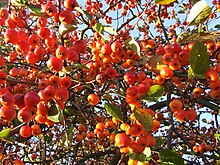
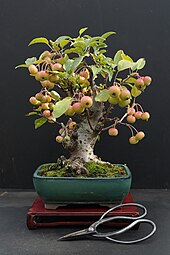
Crabapples are popular as compact ornamental trees, providing blossom in spring and colourful fruit in autumn. The fruits often persist throughout winter. Numerous hybrid cultivars have been selected.[citation needed]
Some crabapples are used asrootstocksfor domestic apples to add beneficial characteristics.[8]For example, the rootstocks ofMalus baccatavarieties are used to give additional cold hardiness to the combined plants for orchards in cold northern areas.[9]
They are also used aspollinizersin appleorchards.Varieties of crabapple are selected to bloom contemporaneously with the apple variety in an orchard planting, and the crabs are planted every sixth or seventh tree, or limbs of a crab tree are grafted onto some of the apple trees. In emergencies, a bucket or drum bouquet of crabapple flowering branches is placed near the beehives as orchard pollenizers.[citation needed]
Because of the plentiful blossoms and small fruit, crabapples are popular for use inbonsaiculture.[10][11][12]
Cultivars
[edit]These cultivars have won theRoyal Horticultural Society'sAward of Garden Merit:-[13]
Other varieties are dealt with under their species names.
Toxicity
[edit]The seeds containcyanidecompounds.[22]
Uses
[edit]Crabapple fruit is not an importantcropin most areas, being extremelysourdue tomalic acid(which like the genus derives from the Latin namemālum), and in some species woody, so is rarely eaten raw. In someSoutheast Asiancultures, they are valued as a sourcondiment,sometimes eaten with salt andchilliorshrimp paste.[citation needed]
Some crabapple varieties are an exception to the reputation of being sour, and can be very sweet, such as the 'Chestnut' cultivar.[23]
Crabapples are an excellent source ofpectin,and theirjuicecan be made into a ruby-colouredpreservewith a full, spicy flavour.[24]A small percentage of crabapples incidermakes a more interesting flavour.[25]AsOld EnglishWergulu,the crab apple is one of the nine plants invoked in thepagan Anglo-SaxonNine Herbs Charm,recorded in the 10th century.
Applewood gives off a pleasant scent when burned, and smoke from an applewood fire gives an excellent flavour tosmokedfoods.[26]It is easier to cut when green; dry applewood is exceedingly difficult to carve by hand.[26]It is a good wood for cooking fires because it burns hot and slow, without producing much flame.[26]Applewood is used to make handles ofhand saws;in the early 1900s 2,000,000 board feet of applewood were used annually for this purpose.[27]
Gallery
[edit]-
Apple blossom. Eastern Siberia
-
Ripe wild crab apples (Malus sylvestris)
-
Baskets of crab apples for sale in Connecticut in 1939
-
Trunk
References
[edit]- ^Cirrus DigitalPurple Prince Crabapple
- ^abc"MalusMill ".Plants of the World Online.Royal Botanic Gardens, Kew.Retrieved17 December2023.
- ^Sunset Western Garden Book,1995:606–607
- ^Phipps, James B.; Robertson, Kenneth R.; Smith, Paul G.; Rohrer, Joseph R. (1990). "A checklist of the subfamily Maloideae (Rosaceae)".Can. J. Bot.68(10): 2209–2269.doi:10.1139/b90-288.
- ^coreyrametta (2019-06-11)."Are Apple Trees Self Pollinating?".Cold Hardy Fruits.Retrieved2024-05-02.
- ^Ken Wilson and D.C. Elfving."Crabapple Pollenizers for Apples".Ontario Ministry of Agriculture and Food.Retrieved12 Sep2013.
- ^abLiu, Bin-Bin; Ren, Chen; Kwak, Myounghai; Hodel, Richard G.J.; Xu, Chao; He, Jian; Zhou, Wen-Bin; Huang, Chien-Hsun; Ma, Hong; Qian, Guan-Ze; Hong, De-Yuan; Wen, Jun (May 2022)."Phylogenomic conflict analyses in the apple genus Malus s.l. reveal widespread hybridization and allopolyploidy driving diversification, with insights into the complex biogeographic history in the Northern Hemisphere".Journal of Integrative Plant Biology.64(5): 1020–1043.doi:10.1111/jipb.13246.ISSN1672-9072.PMID35274452.S2CID247384781.
- ^Apple Tree Rootstocks Ecogardening Factsheet #21, Summer 1999
- ^Alaska Department of Natural Resources [https://web.archive.org/web/20080719050542/http:// dnr.state.ak.us/ag/21Applerootstocks.pdf Archived2008-07-19 at theWayback Machine
- ^Biel, John."Collecting and Training Crab Apples | American Bonsai Society".absbonsai.org.American Bonsai Society. Archived fromthe originalon 3 July 2016.Retrieved2 August2016.
- ^"Crabapple (Malus) - Bonsai Empire".bonsaiempire.Retrieved2 August2016.
- ^Walston, Brent."Crabapples for Bonsai".evergreengardenworks.Retrieved2 August2016.
- ^"AGM Plants - Ornamental"(PDF).Royal Horticultural Society. July 2017. p. 63.Retrieved2 April2018.
- ^"RHS Plantfinder -Malus'Adirondack'".Retrieved25 March2018.
- ^"RHS Plantfinder -Malus'Butterball'".Retrieved25 March2018.
- ^"Malus'Comtesse de Paris'".RHS.Retrieved6 January2021.
- ^"RHS Plantfinder -Malus'Evereste'".Retrieved25 March2018.
- ^"RHS Plantfinder -MalusJelly King = 'Mattfru'".Retrieved25 March2018.
- ^"RHS Plantfinder -Malus'Laura'".Retrieved25 March2018.
- ^"RHS Plantfinder -Malus×robusta'Red Sentinel'".Retrieved25 March2018.
- ^"RHS Plantfinder -Malus'Sun Rival'".Retrieved25 March2018.
- ^The Complete Guide to Edible Wild Plants.United States Department of the Army.New York:Skyhorse Publishing.2009. p. 113.ISBN978-1-60239-692-0.OCLC277203364.
{{cite book}}:CS1 maint: others (link) - ^"The Growing Guide".Stark Bro's Nurseries & Orchards Co. Archived fromthe originalon 2014-07-26.
- ^Rombauer, I.;Becker, M. R.; Becker, E. (2002) [2002].All About Canning & Preserving (The Joy of Cooking series).New York: Scribner. p. 72.ISBN0-7432-1502-8.
- ^"The Science of Cidermaking".Andrew Lea.RetrievedNovember 14,2013.
- ^abcFraser, Anna (22 August 2005)."Properties of different trees as firewood".Retrieved17 July2008.
- ^Burks, Jeff (2015). "Woods Used in Saw Handles". Lost Art Press, Traditional Hand-tool Skills. blog.lostartpress.
External links
[edit]- Germplasm Resources Information Network:Malus
- Flora of China:Malus
- Virginia Cooperative Extension - Disease resistant crabapplesArchived8 February 2007 at theWayback Machine
- The PRI disease resistant apple breeding program:a cooperative amongPurdue University,Rutgers University,and theUniversity of Illinois.





